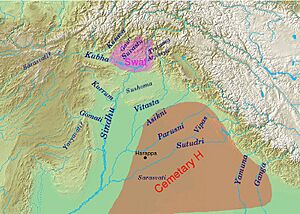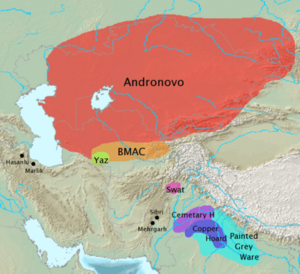Cemetery H culture facts for kids

The extent of the Swat and Cemetery H cultures are indicated; Geography of the Rigveda, with Rigvedic rivers names
|
|
| Geographical range | Pakistan North India (Punjab, Haryana, Western Uttar Pradesh) |
|---|---|
| Period | Bronze Age |
| Dates | c. 1900–1300 BCE |
| Type site | Harappa |
| Major sites | Harappa Bhagwanpura |
| Characteristics | Extensive copper metallurgy cremation of human remains |
| Followed by | Painted Grey Ware culture |

The Cemetery H culture was an ancient group of people who lived in the Punjab region of what is now Pakistan and India. They were part of the Bronze Age, a time when people used tools and weapons made of bronze. This culture existed from about 1900 BCE (Before Common Era) to 1300 BCE. It is seen as a later part of the famous Harappan civilisation (also known as the Indus Valley Civilization). Some experts also think it might show early movements of people called Indo-Aryans.
Where and When They Lived
The Cemetery H culture was found mostly in the Punjab region, which is in modern-day India and Pakistan. It gets its name from a special cemetery found in "area H" at the ancient city of Harappa. Scientists have found remains of this culture that date back from around 1900 BCE to 1300 BCE.
Many experts believe the Cemetery H culture grew out of the northern part of the Indus Valley civilization. This happened around 1700 BCE. It was part of a time called the "Late Harappan phase." This means it was a continuation, not a sudden end, of the earlier Harappan way of life. People didn't just disappear; their way of organizing settlements changed.
Some ideas suggest that the Cemetery H culture might be connected to the Swat culture. The Swat culture is thought to be linked to early movements of people into the Indian subcontinent. This could mean the Cemetery H culture was part of an early wave of people moving into the Punjab region.
Along with other ancient groups like the Gandhara grave culture and the Ochre Coloured Pottery culture, the Cemetery H culture is considered important. These cultures helped shape what later became known as the Vedic civilization in India.
What Made Them Special?
The Cemetery H culture had some unique ways of life. Here are a few things that set them apart:
- Cremation: They often burned their dead. The bones were then placed in special painted pottery jars. This was different from the earlier Indus civilization, where bodies were usually buried in wooden coffins.
- Pottery: They made reddish pottery. This pottery was often painted with black designs. You might see pictures of animals like antelopes or peacocks. They also drew symbols like the sun or stars.
- New Settlements: People from this culture started to move and set up new villages further east.
- Food: Rice became a very important crop for them.
- Trade Changes: The widespread trade that was common in the Indus civilization seemed to slow down. Things like seashells, which were traded a lot before, were not used as much.
- Building: They continued to use mud bricks to build their homes and other structures.
Some of the designs on their pottery might tell us about their beliefs. For example, some jars show peacocks with empty bodies and a small human shape inside. This has been thought to represent the souls of the dead. There are also images of a hound, which some think could be linked to a god of death. These ideas suggest that new religious beliefs might have started during this time. However, there is no proof that the Cemetery H people destroyed the Harappan cities.
Discoveries by Archaeologists
Archaeologists study ancient cultures by digging up and examining old remains. They found that cremation, the practice of burning human remains, first appeared in India with the Cemetery H culture. This practice is also mentioned in ancient texts called the Vedas. For example, one part of the Rigveda, an old Vedic text, talks about ancestors who were "both cremated and uncremated." This shows that cremation was a new but growing practice during this period.
See also
- Chronological dating
- Pottery in the Indian subcontinent
- Indus Valley civilisation
- Vedic period


